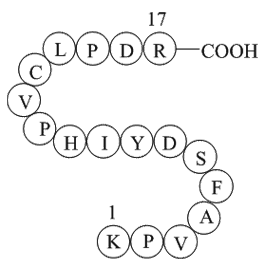coagulation factor II (thrombin) B chain fragment [Homo sapiens]
Thrombin (H2N-Lys-Pro-Val-Ala-Phe-Ser-Asp-Tyr-Ile-His-Pro-Val-Cys-Leu-Pro-Asp-Arg-OH) is a "trypsin-like" serine protease that is encoded by the F2 gene in humans. [1] Thrombin is produced by the enzymatic cleavage of two sites on prothrombin by activated Factor X (Xa). Thrombin in turn acts as a serine protease that converts soluble fibrinogen into insoluble strands of fibrin. Thrombin is also active in the catalysis of many other coagulation-related reactions.
In the blood coagulation pathway, thrombin acts to convert factor XI to XIa, VIII to VIIIa, V to Va, and fibrinogen to fibrin. As part of its activity in the coagulation cascade, thrombin also promotes platelet activation and aggregation via activation of protease-activated receptors on the cell membrane of the platelet.
Thrombin, a potent vasoconstrictor and mitogen, is implicated as a major factor in vasospasm following subarachnoid hemorrhage. Blood from a ruptured cerebral aneurysm clots around a cerebral artery, releasing thrombin. This can induce an acute and prolonged narrowing of the blood vessel, potentially resulting in cerebral ischemia and infarction (stroke).
Beyond its key role in the dynamic process of thrombus formation, thrombin has a pronounced pro-inflammatory character, which may influence the onset and progression of atherosclerosis.[2][3]
Fig 1. The structure of human thrombin in complex with the inhibitor hirudin.
Fig 2. Role of thrombin in the blood coagulation cascade
Ref:
1. Royle NJ, Irwin DM, Koschinsky ML, MacGillivray RT, Hamerton JL (May 1987). "Human genes encoding prothrombin and ceruloplasmin map to 11p11-q12 and 3q21-24, respectively". Somat. Cell Mol. Genet. 13 (3): 285–92.
2. Borissoff JI, Spronk HM, Heeneman S, ten Cate H. Is thrombin a key player in the 'coagulation-atherogenesis' maze? Cardiovasc Res. 2009;82(3):392-403.
3. Borissoff JI, Heeneman S, Kilinc E, Kassak P, Van Oerle R, Winckers K, Govers-Riemslag JW, Hamulyak K, Hackeng TM, Daemen MJ, ten Cate H, Spronk HM. Early atherosclerosis exhibits an enhanced procoagulant state. Circulation. 2010;122(8):821-830. PMID20697022.
| Physical Appearance | A solid |
| Storage | Store at -20°C |
| M.Wt | 1957.26 |
| Formula | C90H137N23O24S |
| Synonyms | H2N-Lys-Pro-Val-Ala-Phe-Ser-Asp-Tyr-Ile-His-Pro-Val-Cys-Leu-Pro-Asp-Arg-OH |
| Solubility | insoluble in EtOH; ≥17.6 mg/mL in H2O; ≥195.7 mg/mL in DMSO |
| SDF | Download SDF |
| Shipping Condition | Small Molecules with Blue Ice, Modified Nucleotides with Dry Ice. |
| General tips | We do not recommend long-term storage for the solution, please use it up soon. |
Quality Control & MSDS
- View current batch:
Chemical structure
![coagulation factor II (thrombin) B chain fragment [Homo sapiens]](/media/diy/images/struct/A1057.png)








